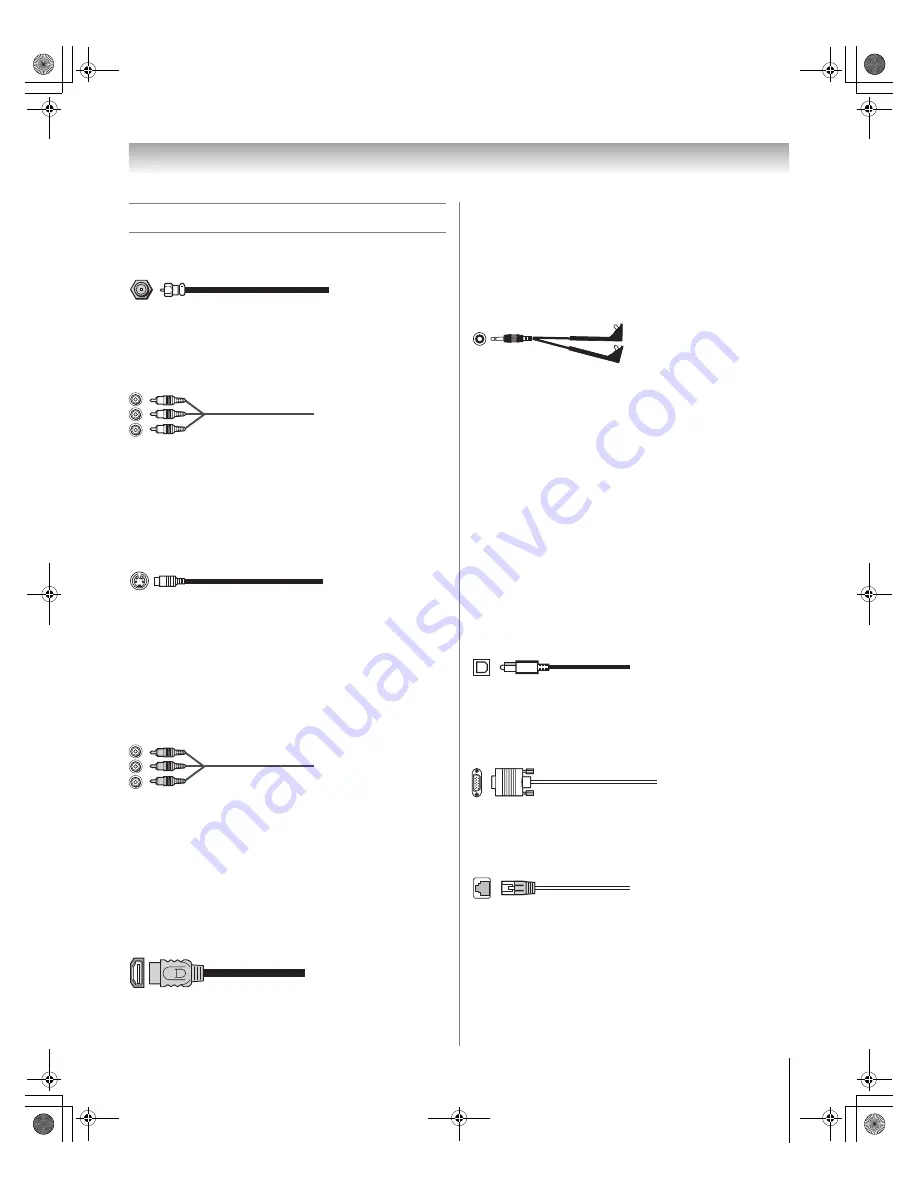
7
DLP Inst (E/F) Web 213:276
Connecting your TV
Overview of cable types
Coaxial (F-type) cable
Coaxial (F-type) cable is used for connecting your antenna,
cable TV service, and/or cable converter box to the
ANT 1
and/or
ANT 2
RF inputs on your TV.
Standard A/V cables (red/white/yellow)
Standard A/V cables (composite video) usually come in sets of
three, and are for use with video devices with analog audio and
composite video output. These cables (and the related inputs
on your TV) are typically color-coded according to use: yellow
for video, red for stereo right audio, and white for stereo left
(or mono) audio.
S-video cable
S-video cable is for use with video devices with S-video
output. Separate audio cables are required for a complete
connection.
Note:
An S-video cable provides better picture performance
than a composite video cable. If you connect an S-video cable,
be sure to disconnect the standard (composite) video cable or
the picture performance will be unacceptable.
Component video cables (red/green/blue)
Component video cables come in sets of three and are for use
with video devices with component video output.
(ColorStream
®
is Toshiba’s brand of component video.) These
cables are typically color-coded red, green, and blue. Separate
audio cables are required for a complete connection.
Note:
Component video cables provide better picture
performance than a standard (composite) video or S-video
cable.
HDMI™ cable
HDMI (High-Definition Multimedia Interface) cable is for use
with devices with an HDMI output. An HDMI cable delivers
digital audio and video in its native format. This cable carries
both video and audio information; therefore, separate audio
cables are not required for a complete HDMI device
connection (
-
page 13).
Note:
HDMI cable provides better picture performance than a
standard (composite) video or S-video cable.
Dual-wand IR blaster/G-LINK™ cable
Dual-wand IR blaster/G-LINK™ cable is for use with video
devices with IR (infrared) remote control. This cable is for
connection to the
G-LINK™
terminal (
-
page 17) to enable
TV Guide On Screen™ recording features (
-
TV Guide
On Screen™ Interactive Program Guide
). This cable also can
be used with the TV’s IR pass-through feature (
-
page 14).
Notes:
•
This applies only to TV models that have the TV Guide
On Screen™ feature. To verify whether your TV model has
this feature, see the table on page 5.
•
The IR blaster/G-LINK™ cable included with your TV have
specific characteristics that allow them to work properly with
this TV’s
IR OUT
and
G-LINK™
ports. Never use other
aftermarket IR blaster or G-LINK™ cables with this TV. Other
cables may not function properly and can cause damage.
THIS TYPE OF DAMAGE IS NOT COVERED BY YOUR
TOSHIBA WARRANTY.
Optical audio cable
Optical audio cable is for connecting receivers with Dolby
Digital or PCM (pulse-code modulation) optical audio input to
the TV’s
DIGITAL AUDIO OUT
terminal (
-
page 16).
Analog RGB (15-pin) computer cable
Analog RGB (15-pin) computer cable is for connecting a PC to
the TV’s
PC IN
terminal (
-
page 18).
Ethernet (RJ-45) cable
Ethernet (RJ-45) cable is used to connect the TV to your home
network (
-
page 19 and the
Operating Guide
).
DLP_Inst.book Page 7 Wednesday, February 22, 2006 6:18 PM








































